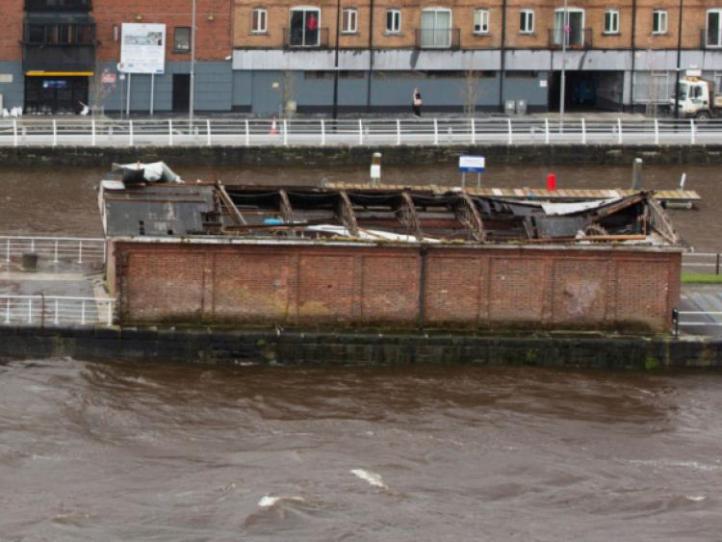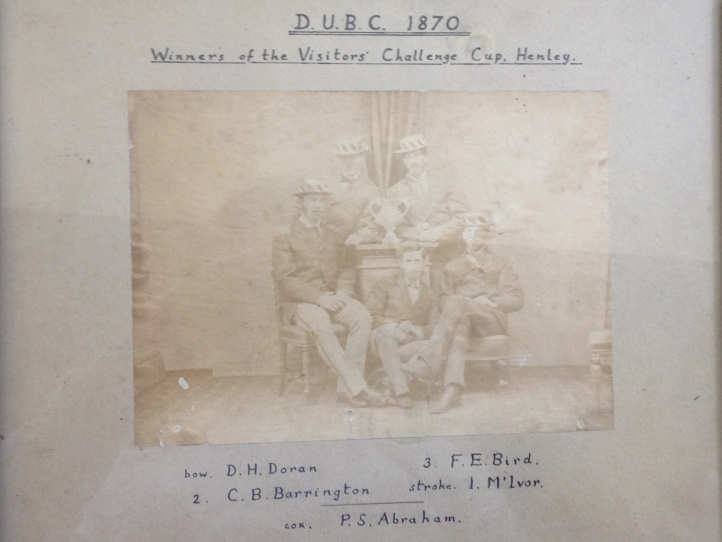
14 July 2017
Greg Deneiffe writes:
12 February 2014 will go down in history as the day that saw a powerful and damaging storm rip the roof off Limerick Boat Club. During the storm, Shannon Airport recorded a maximum gust of 160km per hour, while more than 215,000 Irish homes lost power. There was also extensive coastal flooding and damage to buildings.
The following day, a short video of the club losing its roof went viral, appearing on several social media platforms and on national television throughout Ireland and Great Britain. As 12 February is Darwin Day, the storm was called Storm Darwin and this fact was not lost on the friends of the Limerick club, who in their wisdom, decided to call their recent booklet Life After Darwin – a name that tickles my sense of humour.
Limerick Boat Club is one of Ireland’s oldest clubs and it has a fine history. Recent years may not have seen the club lead the way on Irish waters or on the mighty Shannon, which flows so majestically through Limerick, a city which is also home to Athlunkard Boat Club, St. Michael’s Rowing Club, Shannon Rowing Club and University of Limerick Rowing Club.
Formed in 1870, Limerick BC faced closure before it lost its roof. However, its neighbouring clubs have rallied round to help and Storm Darwin may yet be the saviour of the club and prove that in the rowing world it is not always just the fittest that survive.

Looking to the future, the members of the club are taking a two strand approach – conservation and the development of a new sporting club that will concentrate on the non-competitive and recreational sides of rowing. You can read Life After Darwin on the Irish Rowing Archives website – find the link by clicking on Other Material followed by Club Stuff and Limerick BC.
One of the many members featured in the booklet is of particular interest to me. Charles Burton Barrington, a native Limerick man, was a member of the Dublin University Boat Club (racing as Trinity College, Dublin) crew that won the Visitors’ Challenge Cup in 1870. It was the first time that a Henley Royal Regatta trophy was won by a crew from outside Great Britain. The photograph in the booklet of an 1870 Trinity College four containing Barrington is not of the crew that was victorious over University College, Oxford at Henley. However, it does contain three of its members: F. E. Bird and Ivor M’Ivor, who along with Barrington, D. H. Doran and P. S. Abraham (cox) caused a major upset in the final when they beat the winners of the event for the previous four years. Baily’s Magazine of Sports and Pastimes race reports reads:
The Visitors’ Plate was the great surprise of the meeting, as University College, Oxford, were beaten by the Dublin men. The losers had two races in them, and the Irishmen but one; this, however, was not sufficient to account for the defeat of four tried men, and much credit is due to the Dubliners for the achievement.

The Irish newspaper Freeman’s Journal appear to have taken a shine to the victory and to “our Boat Club”, “our men” and “our University”. It was only three years since the split occurred in Trinity rowing with the formation of a new Boat Club to rival the existing Rowing Club whose colour was dark blue.

The DUBC photograph included in Life After Darwin was chosen as it was the best image of Barrington. Thankfully, a photograph of the victorious Henley crew does exist and Mark Pattison who has been preserving and archiving the club’s photographic collection of more than 350 items for some time is happy to allow HTBS publish it.

DUBC won the Visitors’ twice more in the 1870s. In 1873, they beat Jesus College, Cambridge in a heat and rowed over in the final after Balliol College, Oxford, withdrew. The crew was R. Gage (bow), G. H. Pentland (2), C. B. Barrington (3), Croker Barrington (stroke, brother of Charles and the first Croker oar!) and J. R. H. Sutton (cox). The following year the Visitors’ was retained by the Dublin club but this time without the assistance of a coxswain, 1874 being the first year in which four-oared races were rowed at Henley in coxless boats. The Barrington brothers kept their places and the bow pair was G. N. Ferguson and W. G. Towers (who with R. Gage from the 1873 Visitors’ crew won the Ladies’ Plate with Trinity in 1875).

Dublin University Rowing Club membership was not confined to undergraduates and it is no surprise that some of those mentioned above ‘crossed the floor’ from Boat Club to Rowing Club to continue their rowing careers. Charles Barrington, his brother Croker and G. H. Pentland together with G. A. E. Hickson became the first DURC crew to row at Henley in 1876 when they raced a heat of the Stewards’ Challenge Cup. This was probably a trial run for the club’s entry in the International Four-Oared Race at the Philadelphia Centennial Regatta where G. N. Ferguson replaced Pentland in the bow seat. According to the Match Book of DURC, the Henley crew broke up after Henley and did not get together again until July 22. They then began to practice on the Mulcair River near Glenstal Castle, Co. Limerick, the ancestral home of the Barringtons, where the crew were staying. They purchased an old boat from Kingstown Royal Harbour Boat Club and transported it down to Limerick where they remained until leaving from Queenstown to begin their journey to Philadelphia.
In a June 2011 article Penn’s Visit to Ireland in July 1901, I wrote:
It was the ‘Rowing Club’ that finally accepted an invitation to the important regatta being held to celebrate the centenary of American Independence. They left for America on the 6 August and after arriving in New York travelled on to Philadelphia to compete in the International Four-Oared Race. They were drawn in the first heat against Eureka Boat Club, Newark, N.J. and Argonauta Rowing Association, Bergin Point, N.J. The Dubliners finished second to Eureka by one-and-a-half lengths.
DURC were also entered for the International Graduates’ Prize and rowed over having successfully objected to the status of the only other crew entered. The Irish party then made its way to Washington at the invitation of Analostan Boat Club and raced at an impromptu regatta. The boat was left behind as a mark of gratitude and donated to Quaker City Boat Club in Philadelphia and may have been used by the first Pennsylvania crew in 1879 which, it was said, was composed of Ellis Ward and his three brothers.

There was life in Limerick BC for decades after Barrington left his Castle behind. With the support of the people of Limerick and the other rowing clubs in the city, I’m sure there will be life for the club after Darwin. However, it is not just local support that the club can rely on. In May 2017, the club was delighted to receive a letter of support from Sir Steve Redgrave C.B.E. in respect of their application for a grant of funding for a new roof. Sir Steve wrote:
I would like to send my support for the following grant application. Founded in 1870 Limerick Boat Club is one of the oldest in Europe. The importance of such a well established organisation in a community should not be underestimated.
When the roof was blown off in 2014 I was not surprised to hear that the Committee and members worked tirelessly to clear the debris and get everyone back on the water as soon as they were able. I have personal experience of the devastation something like this can cause to a boat club. My club, Marlow Rowing Club, had a fire on 3rd August, 2011, and with help from the members, local community, and in large grant funding, we were able to rebuild the boathouse and the club continues to thrive and grow.
The power of bringing young people together to undertake physical activity in a safe, fun and secure environment is becoming increasingly important in the world we live in and with this funding the long term stability of the club can continue.
The new roof is needed to safeguard the boats and clubhouse to be enjoyed now and for future generations. Rowing clubs run on a shoestring, so Grant Funding is vital to carry out major work such as your much needed roof.
For these reasons I am in full support of your grant application and hope it is successful.
For more information and the Barringtons, please see the following links to articles in The Old Limerick Journal:
Charles Burton Barrington and Trinity Football Club by Trevor West – an extract from West’s 1991 book The Bold Collegians: The Development of Sport in Trinity College, Dublin, a book I can heartily recommend.
The Sporting Barringtons by Karl Johnston – a wonderful article including reports from DURC’s Match Book on their trip to Philadelphia and Washington. The photographs are very grainy but include one of the cup presented to DURC for winning the Graduates’ Race Cup in Philadelphia, and one of Charles Barrington’s oar from that regatta.
The Death of Winifred Barrington by Kevin Hannan – the story of the shooting to death in 1921 by the I.R.A. of Winifred Barrington, only daughter of Sir Charles Barrington. During the War of Independence Winifred was going out with an English soldier. The I.R.A. tried to assassinate him but botched the job and she was killed. Charles locked up Glenstal and departed for England never to return. He later offered Glenstal Castle as a gift to the Irish Government.
A Letter to Sir Charles Barrington from William T. Cosgrave – the letter (dated 29 July 1925) from Cosgrave, the head of the Irish Government, explains the reason why the generous offer of Glenstal Castle had to be refused.


